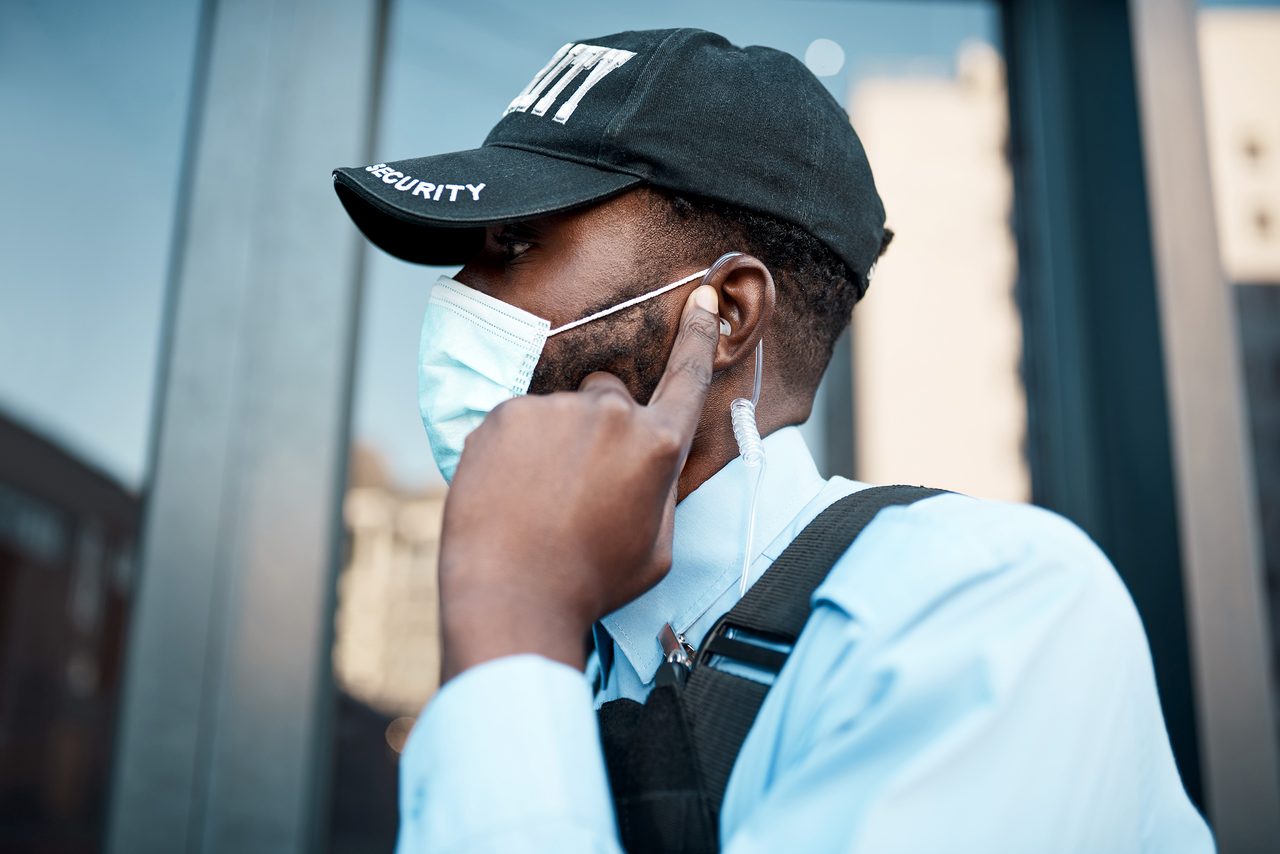december 2021

By John Bartolac, Contributing Writer
Integrated Solutions
As wearable video surveillance continues to be deployed, enterprise security teams in healthcare, retail and more are finding value in improved accountability, transparency and oversight.
Body-Worn Video Camera Use Extends Beyond Policing
Body-worn video surveillance cameras — also described as wearables — have long been a fixture in law enforcement, but more recently, organizations are realizing the benefits to their operations and performance beyond security. This expansion of application use is being seen in a variety of verticals, including healthcare, retail, transportation and education.
Research by public safety experts and economists has shown that body-worn cameras are both beneficial and cost-effective in law enforcement. They have been found to have a positive effect on police response and improve oversight, accountability and transparency. As their popularity has grown in public safety, other verticals have come to appreciate how using wearable cameras can improve safety as well as operations, training and employee performance.

Image courtesy of Axis
As their popularity has grown in public safety, other verticals have come to appreciate how using wearable cameras can improve safety as well as operations, training and employee performance.
Healthcare
The healthcare segment has found body-worn video to be beneficial in many ways. According to the U.S. Occupational Safety and Health Administration (OSHA), serious workplace violence incidents are four times more common in healthcare than in private industry on average. Wearable camera solutions in healthcare facilities — especially emergency rooms — provide opportunities to decrease violent events. In fact, hospitals in the United Kingdom have reported a 28% reduction in workplace violence due to the deployment of wearable video solutions for staff.
Often, the mere presence of a wearable camera — coupled with a warning from hospital staff that employees are wearing cameras — is enough to prevent or quickly deescalate a threatening situation. In these cases, the camera provides a record of what transpired from the staff’s point of view in an investigation or resulting prosecution. Ultimately, it provides the healthcare facility with the ability to learn from the event and assist in response strategies.
Healthcare institutions can also use video from wearables to assist with and document patient care, as we have seen with the pandemic. Additional uses include the transfer of patients to the hospital via emergency services and in assisted surgeries by remote specialists. Patients and healthcare operators feel assured that treatment and procedures are followed correctly and to the best of the staff’s ability. In the end, hospital staff and patients are comforted knowing they have additional eyes on any situation and care was provided correctly and with video to support them.
An additional benefit of body-worn video is evident in training. In these cases, video is used in simulation rooms with residents to illustrate the proper way to deliver care and manage situations in line with healthcare facilities’ care guidelines and policies.
Retail
Retail is an industry that is quickly seeing benefits from the use of wearable cameras. Retailers — be it department stores, grocery chains or restaurants — are focused on improving the customer experience, and wearable cameras recording employee-customer interactions deliver an exceptional tool for ensuring that retailers learn how to improve customer interactions while still providing a record of situations associated with false liability claims.
With the increase in online retail and, specifically, retail delivery — for companies such as Amazon, FedEx and UPS — package tracking and successful delivery are often disputed and result in significant losses to the retailer and delivery companies. According to a report from Convey, “Commitment, Communication and Control: The Modern Customer Delivery Imperative,” 40% of consumers stated that delivery is the single most decisive factor in the shopping experience — and delivery issues could cost retailers $333 million this holiday season alone. To address this issue, carriers like Amazon have instilled the use of drivers taking photos of a package on a doorstep to show proof of delivery. An even better confirmation — and less time-consuming — is to equip drivers with wearable video devices that record every delivery without having to take individual photos at each stop.
Transportation
In the transportation industry, the top priorities with providers and operators are passenger and staff safety, as well as smooth, on-time operations. Wearable camera use in transportation has gained popularity, as video footage can provide both safety and validation of precautions taken on behalf of the operator. There are strict federal, state and local guidelines that govern transportation — be it an airline, railway, marine system or bussing. It’s essential that passenger safety, inspections and maintenance on these methods of transportation be routinely conducted and executed properly. With improved view and documentation of steps taken on behalf of these transportation groups, they know the deployment of such systems can be a matter of life and death and ultimately impact liability.
Transportation organizations and their customers can benefit from documented proof that maintenance tasks have been performed properly. In fact, there is an increasing interest in deploying more wearable cameras in aviation because they have some of the most rigorous maintenance standards of any industry.
Another potential use of body-worn cameras could be in abetting passenger’s concerns regarding loss of checked luggage and theft. The ability to document the chain of custody at all loading and unloading points can dramatically improve the process and outcome when dealing with lost luggage and other claims.
Education
Wearable body cameras in education can be beneficial for both safety and general school operational procedures. On the safety side, school resource officers and local police departments can deploy body-worn cameras for accountability, validation and use of proper procedures as they relate to the on-campus response. Schools are increasingly interested in having their own video (versus relying on local law enforcement) to retain ownership of the event video and conduct independent research of any situation without relying on other groups to obtain documentation and a record of the event.
The Putnam City Schools Campus Police Department in Oklahoma City was an early adopter of body-worn technology. The department uses video to capture forensic evidence in dealing with safety-related incidents. They also use wearables as a tool for improving resource officer operational performance. The department regularly reviews videos captured from wearable cameras to analyze the responses used and what transpired throughout the event, as well as host conversations about how their school resource officers might approach similar incidents in the future.
There is a growing dialogue around schools implementing the use of wearable cameras to provide additional documentation of events and the devices’ use in training. As with any public/private discussion, privacy concerns will come into play. Decisions about how to use the recorded information must be weighed along with the guidelines established under the Family Educational Rights and Privacy Act (FERPA).
Oftentimes, the mere presence of a wearable camera — coupled with a warning from staff that employees are wearing cameras — is enough to prevent or quickly deescalate a threatening situation.
What About Privacy?
As with any technology, body-worn cameras provide organizations with tools and features that can have a positive impact on resolving their current needs, providing increased safety by way of having a record of the event and what actions were taken, as well as improving an organization’s operations to be more efficient and improve the customer and public experience. Privacy is governed by specific standards (such as FERPA). In the end, it’s not the technology that violates privacy laws, but rather how users are taught to use technology through organizational procedures and policy. The technology simply provides additional “eyes” on a given situation. It’s the use of that technology that comes under scrutiny.
Privacy in the healthcare vertical centers around the Health Insurance Portability and Accountability Act (HIPAA), which should always be considered when dealing with recorded video and audio in these environments. Hospitals are required by federal and local laws to inform law enforcement of serious crimes that occur within their facilities and on their premises. As it relates to HIPAA, there is currently no rule, law or requirement stating that it is unacceptable for healthcare providers or third parties to use wearable cameras in hospitals.
The use of recorded video also falls under the Law Enforcement Purposes Act (LEPA). Through LEPA, organizations have the right to disclose any captured information, if required by law, under court order, warrant or subpoena, to identify or locate a suspect, fugitive, witness or missing person.
Cost of Wearable Tech
As the use of body-worn video expands beyond public safety, organizations have expressed concerns over the distinctive law enforcement look that many body-worn devices project to those on the other side of the devices. In response, the industry now offers devices with a smaller, more discreet form factor and in colors other than black, which presents a less threatening profile and provides staff with a device they feel more comfortable using.
The cost of deploying wearables can be a challenge for many industries as they work within their capital and operational budgets. But with more funding resources through federal grant programs and improved sales models, there are plenty of options. The original Coronavirus, Aid, Relief, and Economic Stability (CARES) Act provided funding specifically for those in the healthcare and education sectors to purchase equipment, including video surveillance cameras. For example, schools providing resource officers within local school districts may also be able to use education funding to equip these employees with wearables. Programs like the Bureau of Justice Assistance (BJA) allow criminal justice-related departments within organizations, regardless of vertical, to apply for body-worn camera grants.
Traditionally, enterprise security teams investing in a wearable video solution have been (and still are) faced with recurring fees as well as maintenance costs. In this event, it can be prudent to look for devices based on open-architecture technology, which allows organizations to add the technology to their existing infrastructure or video management system platform. Open architecture can help the organization prepare for future changes in technology and user interfaces.
With the availability of wearable video surveillance, enterprise security leaders can take advantage of the technology by incorporating it into their existing security infrastructure.
About the Author
John Bartolac is Senior Manager, Industry Segment Development at Axis Communications.
Image courtesy of Bartolac





